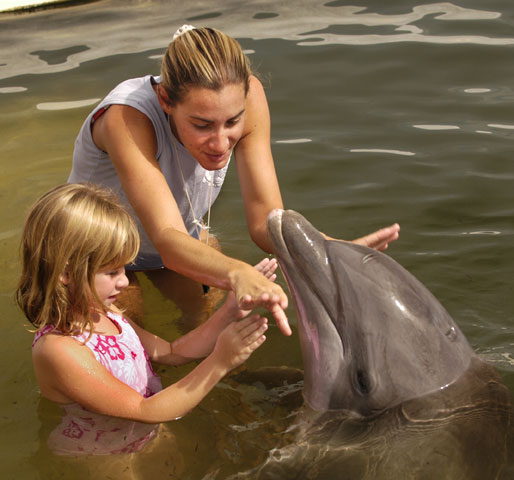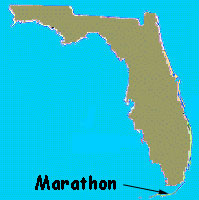FLORIDA
FUN

MARATHON,
Florida Keys -- Florida Keys dolphin centers provide opportunities
for up, close and personal encounters with the intelligent mammals.
At the Dolphin Research Center in Marathon, a youngster gets instruction
from trainer Lindsay Wood, right, how to signal a male dolphin named
Kibby.
(Photo by Bob Krist/Florida Keys News Bureau)
exploring
the
DOLPHIN
RESEARCH
CENTER
|
You're not eating
Flipper The two are not even remotely related. Flipper is a mammal, specifically a delphinid. The dinner special is a tasty game fish, Coryphaena hipparus, also called dorado or mahi mahi. Dolphin/dorado/mahi live in warm waters worldwide and are among the most colorful, beautiful fishes in the sea. Their slender bodies are a brilliant bluish-green with iridescent shimmers of gold, green and purple. Golden yellow fins complete the ensemble. Males are bigger than females and can grow to almost 6 feet long and weigh in at 65 to 70 pounds, though the average is much smaller. The mahi is one of the fastest fish, sometimes clocking speeds of 35 mph (56 kmh). They eat small fish - flying fish are a particular favorite and mahi will jump out of the water to pursue them - as well as shrimp, squid and crabs. Considered one of the tastiest fishes, mahi has a firm texture with large, moist flakes. A 4-ounce portion has about 100 calories, 18.5 grams of protein and 1 gram of fat - plus calcium, iron, vitamin A and a bunch of other stuff that's really good for you. Mahi lends itself to a variety of preparations, from simple grilling to a sautee with Key lime, scallions, shallots, tomatoes and white wine - a favorite at Keys Fisheries Market and Marina in Marathon. The fish is ready to eat when it flakes easily with a fork. Whatever you do, don't overcook it! And don't feel guilty about ordering dolphin next time you see it on the menu.
|
 by
G. K. Sharmin by
G. K. Sharmin
When I was a kid (don't do the math, OK?), one of my favorite TV shows was Flipper, the series about two brothers in Florida who had a dolphin for a pet. A pet dolphin! How cool was that? Every week the friendly finned one would save one of the boys from danger - or help them save someone else. Flipper was strong and graceful and fast and oh so smart. He made my family dog - a perky chihuahua mix that had mastered the fine art of mooching table scraps - seem just the tiniest bit ordinary. And TV-wise, Flipper sure beat Lassie by a big wet bottlenose. So of course I asked for a porpoise for Christmas. The fact that we lived hours from the nearest seawater didn't seem like such a huge obstacle to me. Totally unreasonably - I thought - Mom and Dad refused and stubbornly ignored my fervent promises to feed it every day. But even my skeptical parents would have been impressed by the Dolphin Research Center (www.dolphins.org), an educational, research and dolphin-human interaction facility on Grassy Key. The non-profit center is home to some 16 Atlantic bottlenose dolphins, about half of whom were born at the facility, plus a pair of California sea lions. Don't expect some slick Shamu show where trained animals jump through hoops and take bows on cue. Kibby, Pax, Aleta, Merina, Delphi, Talon, A.J., Tursi and other center residents are just too cool to do that human-is-ring-master stuff. The center's performances, if you want to call them that, are more low key and natural. Slap on some sunscreen, pull up a seat next to one of the lagoons and you can watch as trainers encourage dolphins to whistle, laugh, shake their heads and make "pfffftt" noises. Ever wonder how a vet takes a dolphin blood sample or diagnoses an upset dolphin tummy? You'll find out if you slide down to the adjoining lagoon for the next session. Then in a little while, another group of dolphins will practice their acrobatics. There's a different narrated talk every half hour. As the trainers explain dolphin life and activities to us humans, they sit on a floating dock with a cooler of fish close at hand. When dolphins do the requested behavior, they get a treat. Sometimes, though, the dolphins just aren't in the mood, said media relations coordinator Mary Stella. When that happens, the session is over. Nobody forces the dolphins to "work" when they don't want to. They still get fish later though. (And they eat a lot of it - $800,000 worth every year.) Far more commonly, however, Flipper's cousins thrive on interaction with bipeds of all ages and really ham it up for visitors. In addition to jumping and splashing, they'll blow kisses and bring presents, such as mangrove pods or coral rocks. Sometime they'll even toss one of their hoops your way to entice you to play with them - even if there's not a session going on.
"They do respond to our enthusiasm and attention," said Stella, who adds that she
greets the dolphins every day the same way the rest of us say hello to our co-workers in the morning. Though an undeniable connection exists between us landlubbers and our water-dwelling fellow mammals, reality is a little more complicated. Take those tales of wild dolphins rescuing stranded swimmers and otherwise bonding with us bipeds with a large grain of salt. Delphi, Kibby, Pax and their colleagues are tame and habituated to people, Stella said. Your average dolphin swimming around the ocean is not. And while a wild dolphin probably wouldn't attack, he might want to play with you as he would with his pod buddies - not understanding, of course, that humans aren't designed to roughhouse with 450-pound playmates and can't hold their breath underwater for eight minutes. Still, the call of the water is strong and many of the center's 50,000 annual visitors are prepared to pony up some extra bucks to meet the dolphins on their own...uh, turf. The center runs a number of human-dolphin interaction programs, from a simple meet-and-greet or play-with-the-dolphins session, to the $650 Trainer for a Day experience. All sessions are supervised by trainers and the more involved programs include a class before you're allowed in the water. The center also offers a Dolphin/Child therapeutic program and a week-long Dolphin Lab for kids and adults. The center's research efforts, though not as headline-grabbing as the swim sessions, are a serious priority. Current programs include dolphin intelligence, calf development and communication. The DRC also is the only organization in the Keys authorized to rescue and transport injured manatees. Education is a big part of the center's mission too, and I certainly
learned something important: that a visit to the Dolphin Research
Center is better than having a dolphin for a pet. You get all of
the fun with none of the feeding or clean-up. Looks like Mom and
Dad were right again. |
|
|||||||
|
|
